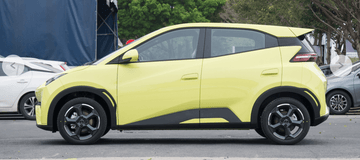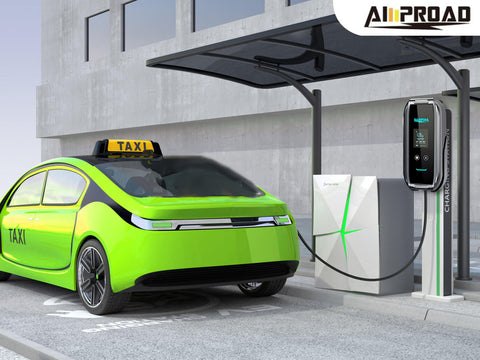
BYD, a renowned Chinese automaker, has set waves in the automotive industry with the release of its latest electric vehicle (EV), the Seagull. Pioneering in electric mobility, BYD has established itself as a leading player in sustainable transportation solutions, garnering attention worldwide for its innovative approach.
The introduction of the BYD Seagull EV is a game-changer, especially with its strikingly low price point of $10,000. This affordability factor is revolutionary, potentially democratizing electric vehicles and making them accessible to a broader spectrum of consumers. By offering an EV at such a competitive price, BYD aims to challenge conventional norms in the auto industry and redefine expectations, ultimately driving widespread adoption of electric mobility.
The BYD Seagull's disruptive pricing strategy has sent shockwaves through the U.S. auto industry, compelling competitors to reassess their pricing models and product offerings. With the Seagull's affordability, BYD aims to break down barriers to EV ownership and accelerate the transition towards sustainable transportation on a global scale. As consumers increasingly prioritize environmental sustainability and cost-efficiency, the BYD Seagull emerges as a compelling option that aligns with these evolving preferences, posing a significant challenge to traditional automakers.
The BYD Seagull EV
Specifications
BYD's Seagull EV boasts impressive specifications designed to meet the needs of modern drivers. With a notable range of approximately 250 miles on a single charge, it offers ample mileage for daily commutes and longer journeys alike. The vehicle is equipped with a high-capacity battery, providing sufficient power to sustain extended drives without compromising performance. Additionally, the Seagull features advanced safety features and cutting-edge technology, ensuring a comfortable and secure driving experience for passengers.
Potential Target Market
The BYD Seagull EV is positioned to appeal to a diverse range of consumers, particularly those seeking an affordable yet reliable electric vehicle. With its competitive price point of $10,000, the Seagull targets budget-conscious individuals who prioritize value and sustainability. Furthermore, it serves as an ideal option for first-time EV buyers looking to transition to electric mobility without breaking the bank. By offering a compelling combination of affordability, efficiency, and eco-friendliness, the Seagull aims to capture a significant share of the electric vehicle market.
Charging Capabilities
In terms of charging capabilities, the BYD Seagull EV is equipped with an onboard charger capable of handling Level 2 EV charger. This feature enables efficient charging at home or public charging stations, providing added convenience for drivers. With its compatibility with Level 2 EV charger, the Seagull offers faster charging times compared to standard Level 1 chargers, allowing users to replenish the battery more quickly and get back on the road with minimal downtime. This versatility in charging options enhances the overall user experience and contributes to the appeal of the Seagull as a practical and user-friendly electric vehicle option.
Impact on the U.S. Auto Industry

The introduction of the Seagull EV at an exceptionally low price point has the potential to disrupt the U.S. auto industry in various ways. Firstly, its affordability could exert pressure on existing electric vehicles (EVs) in the market, prompting manufacturers to reconsider their pricing strategies and possibly initiate price wars to maintain competitiveness. This could lead to a significant reshaping of the EV market landscape, with consumers benefiting from increased affordability and accessibility to electric vehicles. Traditional automakers may face challenges in adapting to the changing dynamics of the market, particularly in response to the Seagull's competitive pricing. Competing with BYD's offering may require them to reassess their product offerings and pricing structures to remain competitive in an increasingly price-sensitive market.
Moreover, the emergence of the Seagull EV could drive greater attention to home charging infrastructure, particularly the adoption of Level 2 EV charger. As budget-conscious buyers gravitate towards more affordable EV options like the Seagull, they may prioritize home charging solutions to maximize cost savings and convenience. This shift towards home charging infrastructure could incentivize EV ownership among a broader consumer base, especially those who rely on home charging as their primary charging method. As a result, there may be increased investment and innovation in home charging technologies and infrastructure to accommodate the growing demand spurred by affordable EV options like the Seagull. Overall, the impact of the Seagull EV on the U.S. auto industry extends beyond pricing dynamics, influencing consumer preferences, market competition, and the development of charging infrastructure.
Potential Responses from U.S. Automakers
In response to the disruptive entry of the BYD Seagull EV into the market, U.S. automakers may consider several strategies to maintain their competitiveness and adapt to changing consumer demands.
Price Adjustments for Existing EVs
One potential response from U.S. automakers could involve adjusting the prices of their existing electric vehicles to remain competitive with the BYD Seagull EV. Notable figures like Elon Musk, CEO of Tesla, have previously emphasized the importance of pricing in the EV market, acknowledging the need to offer compelling value propositions to consumers.
Increased Focus on Developing Affordable EVs
Another possible approach for U.S. automakers is to ramp up efforts in developing affordable electric vehicles equipped with efficient home charging capabilities. Influential voices in the automotive industry, such as Mary Barra, CEO of General Motors, have expressed the company's commitment to expanding its EV lineup and making electric vehicles accessible to a wider range of consumers.
Innovation in Battery Technology
To address the challenge posed by the BYD Seagull EV's low price point, U.S. automakers may also invest in research and development efforts focused on enhancing battery technology and production efficiency. Renowned experts in the field of electric vehicles, such as JB Straubel, former CTO of Tesla, have advocated for continuous innovation in battery technology as a key driver for reducing costs and improving the overall performance of electric vehicles.
Future of BYD Seagull EV
The arrival of the BYD Seagull EV has the potential to significantly impact the U.S. auto industry in various ways. One aspect to consider is its influence on home charging infrastructure, particularly the adoption of Level 2 chargers. Experts predict that the Seagull's affordability and emphasis on home charging capabilities could accelerate the adoption of Level 2 chargers among consumers. This could lead to a more widespread and robust home charging infrastructure, facilitating the transition to electric vehicles for a larger segment of the population.
Additionally, the introduction of the BYD Seagull EV may prompt shifts in consumer buying habits regarding electric vehicles. With its disruptive $10,000 price point and focus on accessibility, the Seagull has the potential to attract budget-conscious consumers and first-time EV buyers who may have been hesitant to make the switch in the past. This could contribute to a more competitive and dynamic EV market landscape, with a broader range of offerings catering to diverse consumer preferences and budgets.
Furthermore, the emphasis on Level 2 home charging solutions by the BYD Seagull EV may signal a broader trend within the industry. Automakers may increasingly prioritize the development of affordable EVs equipped with efficient home charging capabilities, recognizing the importance of addressing charging infrastructure concerns to drive EV adoption. This strategic shift could lead to a more robust ecosystem of electric vehicles and charging infrastructure, ultimately benefiting consumers and advancing the transition to sustainable transportation.
The BYD Seagull's Potential

The BYD Seagull EV has emerged as a disruptive force in the U.S. auto industry, primarily due to its remarkable price point of $10,000. This affordability has the potential to democratize electric vehicle ownership and significantly expand the market, particularly among budget-conscious consumers and first-time EV buyers. Moreover, the Seagull's emphasis on home charging capabilities, including compatibility with Level 2 chargers, could catalyze the adoption of residential charging infrastructure across the country.
Ultimately, the BYD Seagull EV represents a significant milestone in the evolution of the U.S. auto landscape. Its affordability and focus on home charging solutions have the potential to revolutionize consumer attitudes towards electric vehicles and drive widespread adoption. By prioritizing Level 2 charger compatibility, the Seagull paves the way for a more accessible and sustainable future of transportation in the United States. As automakers and policymakers respond to the Seagull's disruptive impact, the stage is set for a transformative shift towards electrification and enhanced charging infrastructure nationwide.
FAQs
Will the BYD Seagull EV be available globally?
Currently, the BYD Seagull is only available in China and Latin America (as the BYD Dolphin Mini).
BYD has not announced plans to enter the U.S. market yet, though its affordability has caused concern among some U.S. automakers
What impact might the BYD Seagull have on existing electric vehicle markets?
Priced at approximately $9,773, the BYD Seagull emerges as a highly competitive contender in the electric city car category due to its remarkably low cost. This affordability may pose a challenge to other manufacturers, compelling them to explore ways to make their electric vehicles more accessible and budget-friendly. As consumers increasingly prioritize cost-effectiveness and environmental sustainability, the Seagull's affordability could potentially disrupt the market by encouraging other automakers to develop more affordable electric vehicle options. In response to the Seagull's competitive pricing, competitors may need to reassess their pricing strategies and innovate to meet the growing demand for affordable electric vehicles.
Are there any incentives or rebates available for purchasing the BYD Seagull in the U.S.?
Since the BYD Seagull isn't available in the U.S. yet, there are no current incentives or rebates specific to this model.
However, there are federal tax credits available for electric vehicles that meet certain requirements are per US Department of Energy.
How does the BYD Seagull compare to other affordable electric vehicles on the market?
The BYD Seagull distinguishes itself in the electric vehicle market with its remarkably low price point, making it an enticing option for budget-conscious consumers. While other affordable EVs may offer greater range or additional features, they typically come with a higher price tag. However, the Seagull's affordability may come with trade-offs in terms of range, features, or overall performance. To provide a more accurate comparison between the Seagull and other electric vehicles, it's essential to consider specific models and their respective specifications and capabilities. By assessing factors such as range, features, charging capabilities, and price, consumers can make informed decisions based on their individual preferences and requirements for an electric vehicle.


